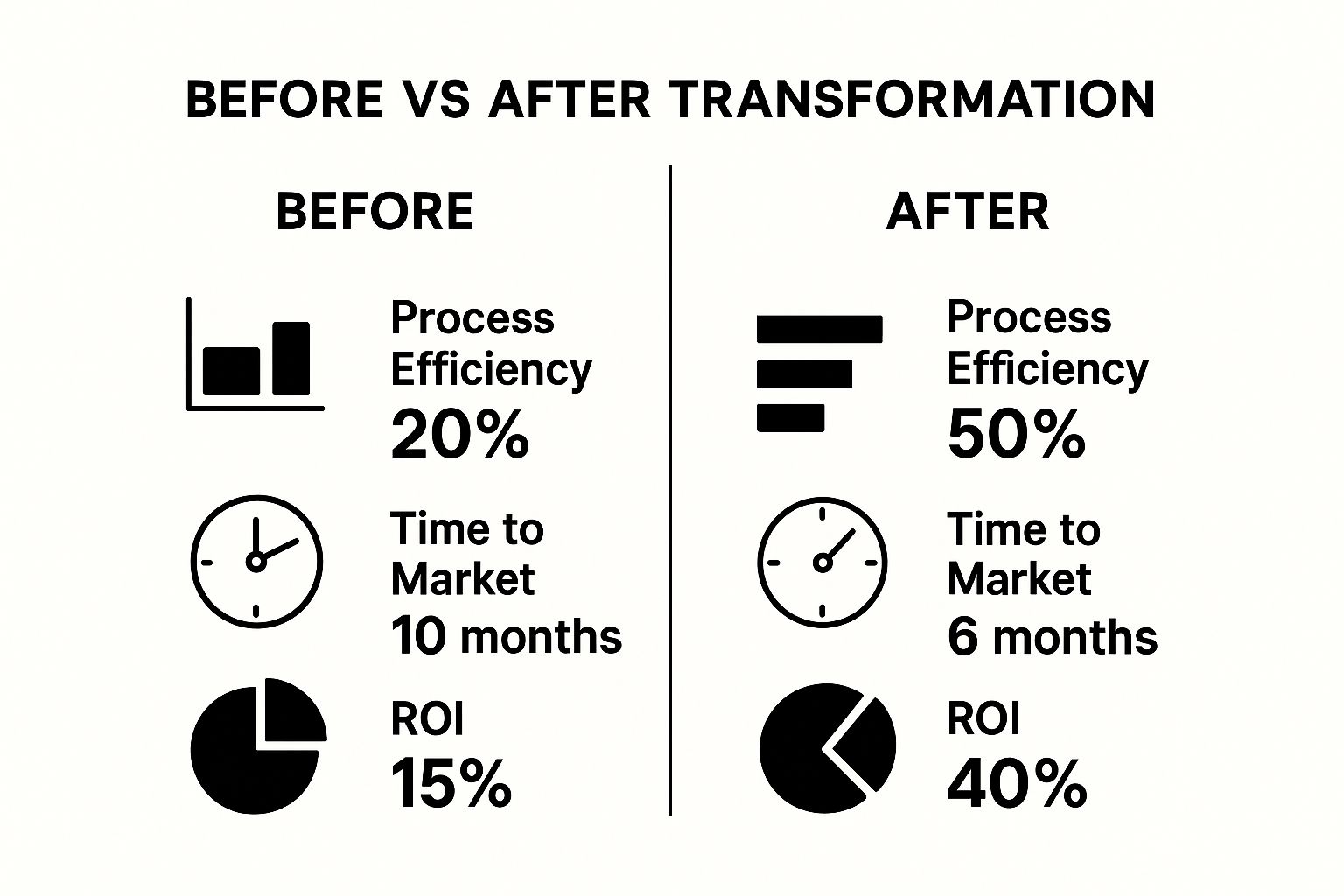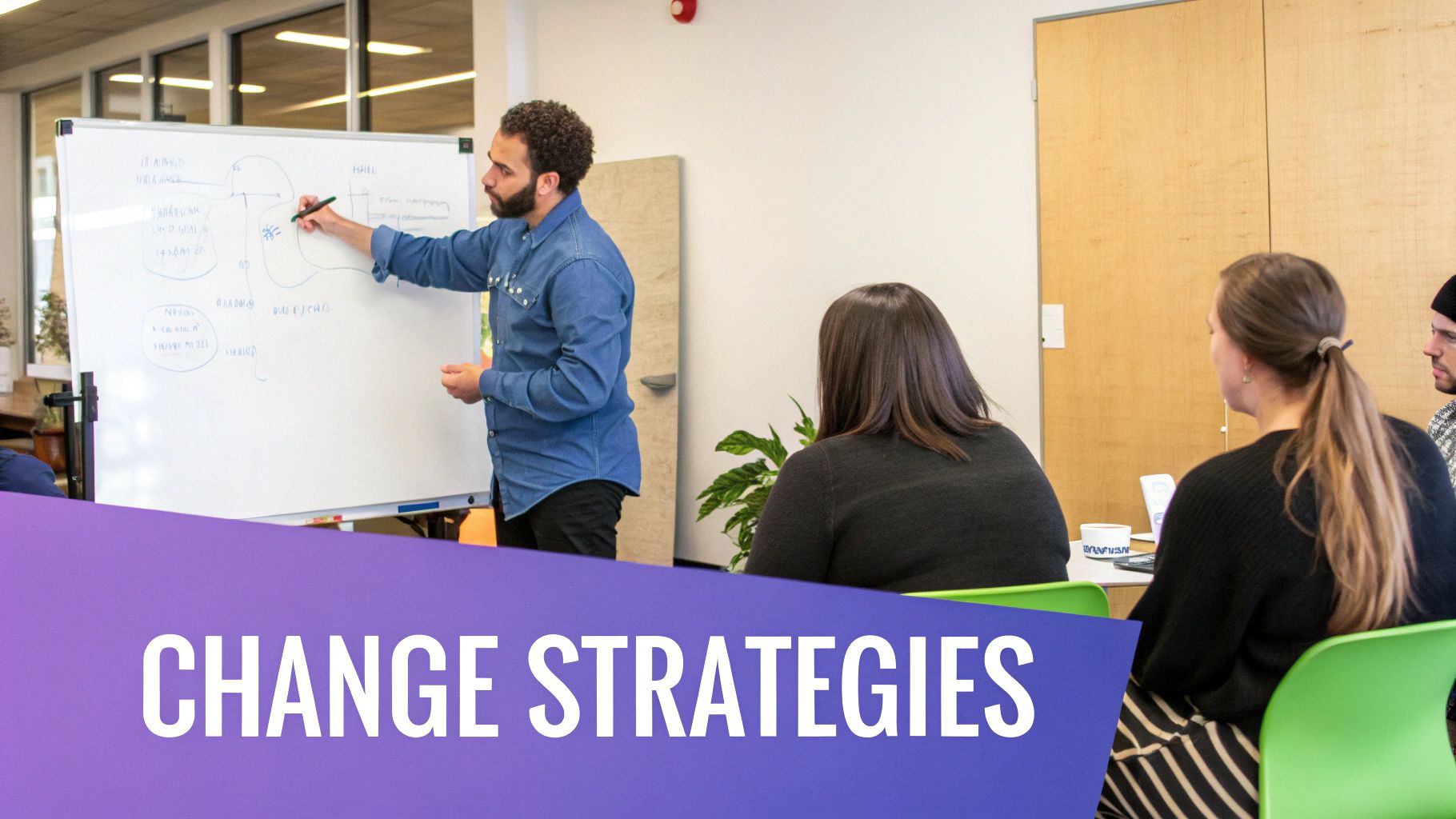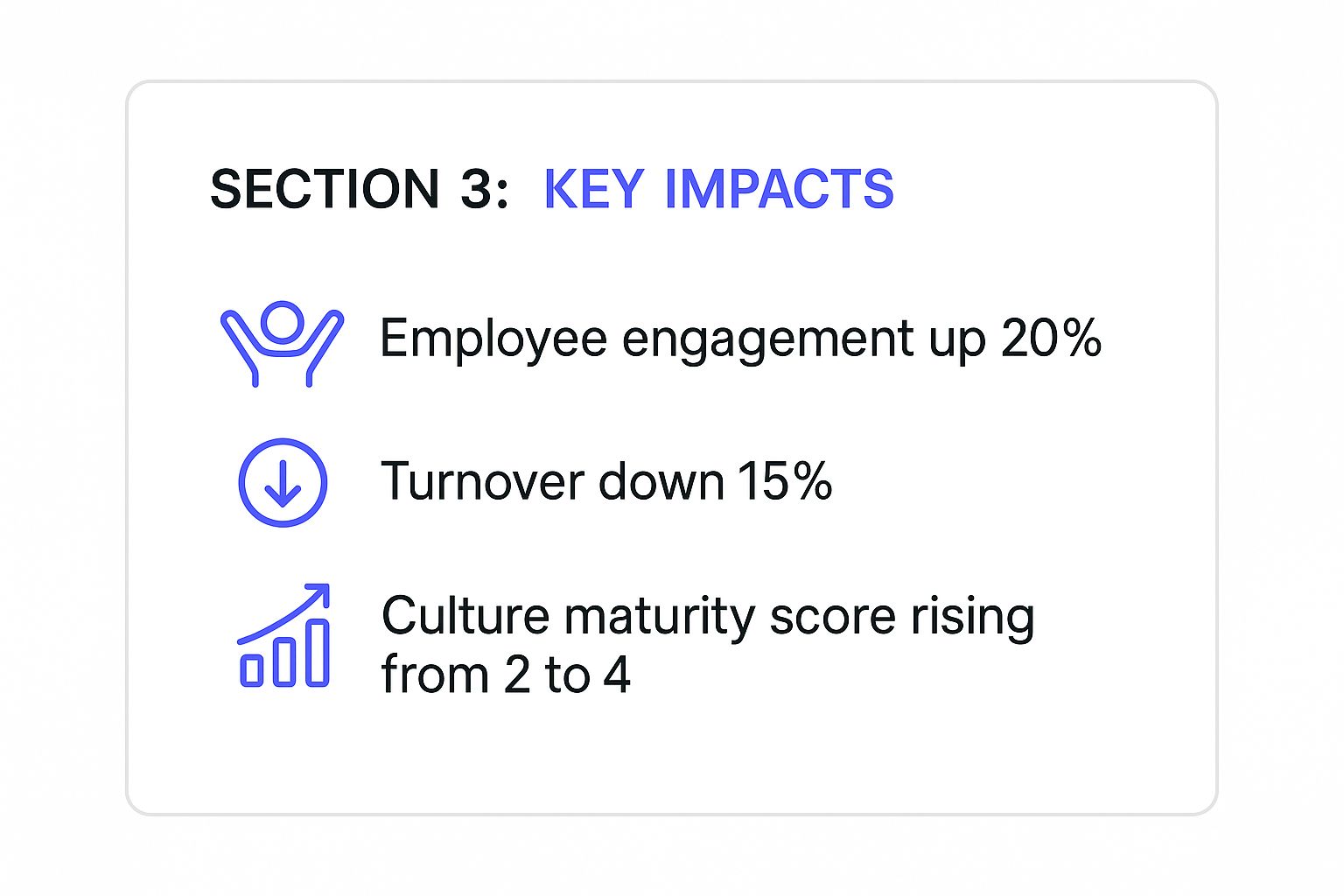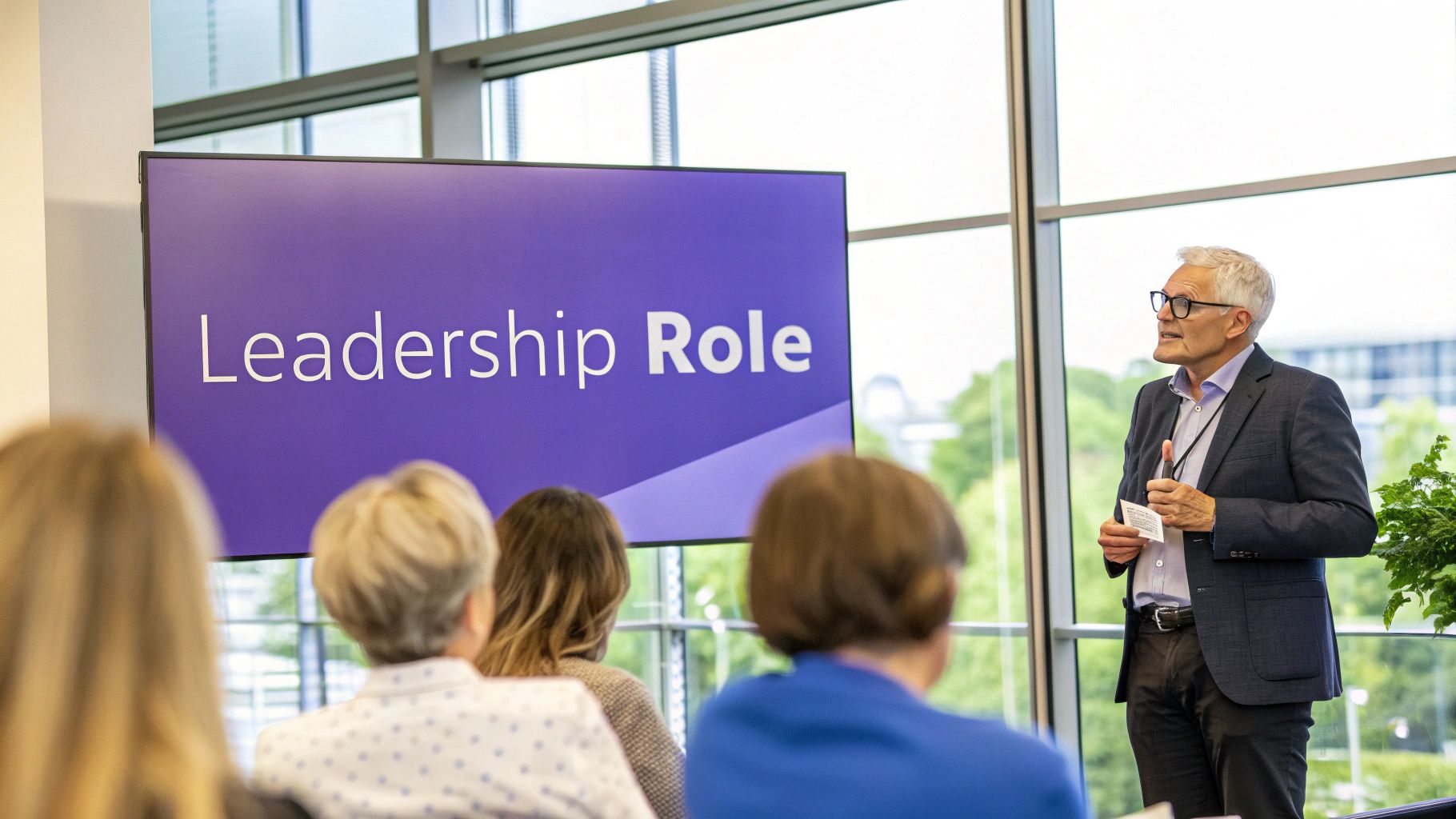Many leaders know the feeling. Your organisation hits a wall. Progress grinds to a halt. Teams work in silos. The way forward is foggy. This is a common problem. Fixing it takes more than small tweaks. It requires a rethink of how your people, processes, and technology work together.
Why Most Business Transformations Fail to Deliver
Here is an uncomfortable truth. Most transformation projects fail. Some studies suggest the failure rate is as high as 70%. This rarely happens because of one big mistake. Failure is usually a slow creep. It is the result of small missteps that pile up over time.
A classic error is putting technology first. A company buys a new software platform that promises efficiency. The company then drops it into an organisation that is not ready. No one asked the people who would use it. No one mapped out existing workflows. The expensive new tool ends up causing more problems than it solves.
The Human Element Is Often Ignored
Real, lasting change starts with people. It is about shifting how individuals and teams think, work and make decisions. Without that cultural shift, any new process or system is built on shaky ground. The biggest obstacle is often inertia. People are used to doing things the old way, even if it is clunky and inefficient.
What is blocking your progress? To get a positive, long-term impact, you must confront that inertia directly. This means creating a space where people can have honest conversations about what is actually broken. It is the first crucial step towards building collective intelligence. This is where the shared knowledge of your entire team becomes your most powerful asset.
Yopla’s mission is to make business better. We believe this means creating organisations that are more open, thriving, and operationally sustainable. This starts by empowering people to contribute their best work.
Symptoms of a Stalled Transformation
How can you tell if your project is heading off the rails? The signs are clear if you know what to look for. Think of them as roadblocks that drain clarity and kill momentum.
- Siloed Knowledge: Information gets trapped within departments. This prevents any kind of shared awareness because nobody has the full picture.
- Misaligned Leadership: The executive team has conflicting priorities. This sends mixed signals down the chain and breeds confusion.
- Lack of Ownership: Employees feel the transformation is happening to them, not with them. They have no real skin in the game.
- Focus on Activity, Not Outcomes: Everyone is busy. Meetings are constant. To-do lists are long. Yet no one makes measurable progress toward strategic goals.
Getting past these issues requires a focused, outside perspective. This is where skilled business transformation consultants show their value. They do not just install a new system. They act as catalysts for change, starting with your people.
What is the practical next step? Map out how work actually gets done. Do not rely on how you assume it gets done. This honest look in the mirror is the only way to uncover the real blockages. Where is your organisation truly stuck?
What a Business Transformation Consultant Actually Does
Let us cut through the jargon. What does a business transformation consultant really do? Forget the image of someone who delivers a glossy report then disappears. A great consultant is a catalyst for change, not just an advisor.
Their job is to help you see your own organisation with fresh eyes. They pinpoint what is truly holding you back. Then they work alongside you to build a practical roadmap for genuine change. They do this by asking tough questions and challenging the "we have always done it this way" mindset. The goal is to build real momentum and turn inertia into focused, effective action.
It all starts with your people. A consultant’s first task is to listen to your teams and understand their world. They hear about daily frustrations, clever workarounds, and brilliant ideas trapped inside departments.
Uncovering the Real State of Play
Before you can fix anything, you must understand how it actually works. A consultant's initial focus is not on organisational charts or formal procedures. They map out how work really gets done, day in and day out.
This discovery process creates a single, unified picture of the business. Everyone can agree on it. We call this achieving shared awareness. It gets everyone, from the leadership team to the front line, to see the same challenges and opportunities. This foundation makes every following decision smarter.
Only once you have this human-centred understanding can you redesign processes. You cannot fix a workflow you do not fully understand. By starting with people, a consultant ensures any new process is built around how your teams can be most effective.
From Process to Practical Technology
Technology is the last piece of the puzzle. This is for a good reason. Tools should serve people, not the other way around. We have all seen companies spend a fortune on new software. It often causes more headaches because it was not chosen to solve the right problems for the right people.
A skilled business transformation consultant helps you choose and implement technology that directly supports your new processes. This approach ensures your investment delivers a real return. The ultimate aim is to achieve digital sovereignty. This is where you own and control your systems, data, and digital future. You are not locked into a vendor or the consultants themselves.
Yopla’s mission is to make business better. A core part of this is building organisations that are more open, thriving and operationally sustainable. This means ensuring technology empowers people, creating clarity and a dividend in freed time.
Demand for this kind of deep, specialist work remains high. The Management Consultancies Association (MCA) projects a slower overall growth of 6.4% for the UK consulting sector after a post-lockdown boom. However, leaders still see the need for expert business transformation consultants who can integrate systems and drive real change as a top priority.
Building Lasting Capability
The true measure of success is not just launching a new system. It is creating a plan your teams feel they own because they helped build it. This collaborative approach separates lasting change from a short-term fix. It unlocks the collective intelligence of your organisation. This ensures the best ideas are heard and acted upon.
When this is done right, the benefits are tangible:
- Symmetric Insights: Information and understanding flow freely across all levels, breaking down departmental silos.
- Dividend in Freed Time: Streamlined processes cut wasted effort. This gives your people more time to focus on high-value work.
Ultimately, a good consultant works to make themselves redundant. They transfer knowledge and build skills within your teams. They leave you with a stronger, more self-sufficient organisation. You can explore how our service delivers these lasting changes.
Does this picture match your view of a consultant? Or did you still think of them as temporary advisors offering opinions from the sidelines?
The Four Outcomes of a Successful Transformation
It is easy for transformation projects to miss the mark. Too often, leaders fixate on vanity metrics like a flashy new CRM. They mistake activity for progress. Real success is not about ticking boxes. It is measured by lasting, positive changes in how your organisation operates every day.
A successful transformation delivers four specific outcomes. These are not typical technical KPIs. They are tangible shifts in your company's core capabilities. They form the bedrock of an operationally sustainable business. These are the outcomes that experienced business transformation consultants help you achieve.
1. Collective Intelligence
The first goal is to unlock your collective intelligence. This is the art of tapping into the combined knowledge of all your people. Your organisation probably has most of the answers it needs. The problem is that knowledge is often trapped in departmental silos, hidden in spreadsheets, or stuck in a few heads.
What is blocking progress? It is usually a culture that does not reward open sharing. Or a rigid structure that stops teams from talking. People work on their own small piece of the puzzle. They never see the full picture.
A people-first approach demolishes these walls. It creates forums and processes where a crucial insight from the factory floor can inform boardroom strategy. A practical next step is to map how information really flows. Then you can identify bottlenecks and build bridges between your teams.
2. Shared Awareness
This leads to the second outcome: shared awareness. This is more than sending another company-wide email. It means everyone, from the CEO to a new starter, understands the company’s goals. They know the current challenges. They see how their role contributes to moving forward.
Without this unified view, departments pull in different directions. The marketing team launches a promotion the operations team cannot support. The sales team promises features the product team will not build. It is organised chaos.
Yopla’s mission is to make business better. A business gets better when it becomes more open and thriving. This happens when every person has the clarity to see how their work contributes to the bigger picture.
Achieving this requires a single source of truth about the state of the business. It means developing a common language and a shared perspective on what truly matters. When everyone looks at the same map, they can navigate challenges together.
3. Symmetric Insights
Third, a successful transformation delivers symmetric insights. This idea is powerful and simple. It means crucial data is available to everyone who needs it. Not just a select few in leadership or the analytics department.
In most businesses, information is asymmetric. Leaders see dashboards and reports that frontline staff never see. This creates a disconnect. Major decisions are made without vital context from the people who do the work.
Making insights symmetric empowers people at every level. A call centre agent with supply chain data can give a customer an accurate delivery time. A shop floor manager who sees real-time sales trends can adjust production schedules. This builds incredible momentum and a culture of ownership. A great start is to identify one key piece of data that could empower a frontline team. Then find a simple way to share it.
4. Dividend in Freed Time
The final outcome is the dividend in freed time. This is the ultimate return on investment for any transformation. It is the extra capacity you create when smarter processes and better systems eliminate wasted effort.
Think about the hours your best people spend on manual data entry or chasing approvals. A study by Automation Anywhere found that office workers spend over three hours a day on easily automatable tasks. That is a staggering drain on productivity and morale.
This freed time is a dividend you can reinvest in the business. Your teams can spend less time on tedious work. They can spend more time innovating, serving customers, and thinking strategically. This is how you build a lasting positive impact and an organisation built to improve.
Do your change initiatives measure success in new software, or in new capabilities for your people?
How to Choose the Right Transformation Partner
Picking a transformation partner is the most important decision you will make. Get it wrong and you face wasted money, a disillusioned team, and a stalled project. With the right partner, you gain clarity, build momentum, and create lasting, positive change.
This is not about slick presentations or long client lists. It is about finding a team that clicks with your culture and shares your vision for a better business. You need people who put your team first. People who get to the heart of your unique struggles. People who are committed to making you self-sufficient.
Moving Beyond the Tick-Box Exercise
Your standard procurement checklist often misses the point. It focuses on features, pricing, and case studies. It overlooks the consultant's core philosophy. How do they actually work with people? What is their plan for building capability within your organisation?
A true partner is all about co-creation. Their job is to unlock the collective intelligence that already exists within your teams. They do not arrive with a pre-baked solution. Instead, they guide conversations that empower your people to pinpoint obstacles and design smarter ways of working.
The infographic below shows the clear, measurable improvements you can expect from a well-run, people-first transformation.

These numbers tell a story of a shift from slow, clunky processes to a more agile, profitable way of operating. It is proof of the tangible returns from the right partnership.
Finding the best business transformation consultants means you have to dig deeper. You are looking for someone who will challenge your assumptions, not just nod along. Their real value is in bringing a fresh pair of eyes and the structure you need to turn ideas into actions.
Evaluating Business Transformation Consultants: A Comparison
Choosing a partner requires a shift in mindset. You must move from traditional metrics to those that prioritise people and long-term capability. The table below outlines what to look for and what to avoid.
Ultimately, a people-first approach is not just a feel-good strategy. It is the only way to ensure the changes you make will stick.
From Evaluation to Action
So, how do you find this ideal partner? You need to ask better questions. Steer the conversation away from generic sales pitches. Focus on their specific methods and beliefs.
Here are a few questions to get you started:
- How will you get to know our teams and understand how things really work here? Listen for answers that include workshops, interviews, and time spent observing work. Be cautious of anyone who plans to work only from documents.
- What is your strategy for dealing with resistance to change? A good partner knows resistance is normal. They should have a clear plan for listening to concerns and building genuine buy-in.
- How do you ensure the knowledge stays with us when you leave? The aim is lasting skill, not reliance. Ask exactly how they will train your people and document new processes so you can keep improving on your own.
- How will you measure success? Their answer should reflect the four key outcomes: building collective intelligence, achieving shared awareness, generating symmetric insights, and creating a dividend in freed time.
The final decision boils down to trust and alignment. Do you believe this partner has your best interests at heart? Do they share your vision for a more open, effective, and sustainable organisation?
Before you start the search, get a clear picture of your starting point. A structured assessment like a digital maturity audit can give you a solid baseline of where you stand today.
Choosing a consultant is not just another procurement task. It is the first real step in your transformation. Are you evaluating partners on their presentation skills, or on their ability to empower your people and deliver lasting change?
Real-World Examples of the Transformation Dividend
Theory is one thing. Results are what matter. What does a successful business transformation look like on the ground? When you partner with experienced business transformation consultants, the focus moves from slide decks to tangible outcomes that change how work gets done.
These stories, with company details kept private, show the real dividend that is possible. They get to the heart of the human impact. They show how creating clarity and momentum gives people the power to solve problems and innovate. This is what we do at Yopla. We make business better by making it more open, thriving, and operationally sustainable.
Unlocking Collective Intelligence in Manufacturing
A mid-sized manufacturing firm was bleeding money through waste. Scrap rates were high. Production delays caused friction between the shop floor and management. The leadership thought it was a machinery problem. The real issue ran deeper. Nobody was listening to the people who operated the machines every day.
The solution was to focus on people first. Consultants helped introduce a new, simple daily communication process. This created forums where operators could flag problems and pitch improvements to engineers. It was a simple change. It unlocked the team's collective intelligence.
What happened? The operators quickly pointed out several small machine faults that were causing huge material waste. Within six months, the firm cut its overall waste by 30%. The dividend in freed time was huge. Engineers could stop firefighting and start focusing on process improvements.
Creating Shared Awareness in Retail
A growing retail business faced a classic headache. Its most popular items were often out of stock. This led to unhappy customers and lost revenue. The buying, marketing, and warehouse teams were all working in their own bubbles. They used different data and forecasts. This lack of shared awareness meant they were always one step behind.
The practical first step was not to install complex new software. It was simpler. They built a single, shared view of the supply chain. This involved agreeing on a core set of metrics and creating a shared dashboard. This gave everyone a clear, unified picture of stock levels and sales.
This shift created clarity. It broke down the silos that were blocking progress. When everyone could see the same picture, they started working together to solve the right problems. This delivered a lasting positive impact.
With this new alignment, the company cut stockouts by 20% in the first year. The marketing team could plan promotions confidently. The warehouse could manage its inventory far more effectively. They achieved digital sovereignty by owning their process, not just relying on external tools. You can explore similar stories of success in our detailed case studies.
Achieving Symmetric Insights in Financial Services
At a competitive financial services firm, the frontline advisors felt stuck. They had to escalate even minor customer issues. They lacked the information or authority to solve them. Management held all the key data. This created a bottleneck where symmetric insights were impossible.
The transformation here was about empowering these frontline teams. Consultants worked with them to pinpoint what information they needed to resolve most queries on the first call. This meant securely opening up access to specific account and policy data, backed by focused training.
The change was dramatic. Customer satisfaction scores shot up. So did employee morale. It was a perfect example of the dividend in freed time in action. Advisors were no longer bogged down in escalations. They were building stronger client relationships. This kind of impact is driving major growth in the UK consulting sector. It now employs around 245,200 people and is forecast to grow by up to 7.8% as businesses seek this expertise. You can learn more about the UK consulting sector's strong growth from the Management Consultancies Association.
Real transformation is not about grand gestures. It is about smart, targeted changes that remove blockages and empower your people.
What is the single biggest blockage holding back your teams right now?
Are You Ready to Build a Better Business?
Embarking on a business transformation journey starts with one crucial step. It is a moment of uncomfortable honesty. Leaders must admit that the old ways are not working. It is a commitment to building something better and something designed to last.
This is not about jumping on the latest management trend. It is a deliberate choice to shift from being busy to taking focused action. It takes courage to look beyond daily firefighting. You must ask what is genuinely holding you back. Are your people bogged down by clunky processes? Is crucial knowledge siloed in different departments?
The Courage to Ask and to Act
Many organisations find themselves stuck. They are running hard but staying in the same place. Calendars are packed, yet there is no real forward momentum. The first, most critical step is to pause and create space for an honest chat.
This is where skilled business transformation consultants can be a game-changer. They act as a catalyst. They help you see your business through fresh eyes. Their job is not to hand you pre-packaged answers. It is to help you ask the right questions. They guide the tough conversations needed to build shared awareness and tap into the collective intelligence within your teams. This people-first approach lays the groundwork for real, lasting change.
Yopla’s mission is to make business better: more open, thriving and operationally sustainable. This is not a lofty ideal. It is a practical promise to deliver clarity, empower your people, and protect your digital sovereignty.
This journey is about developing new capabilities, not just rolling out new software. It is about generating symmetric insights, ensuring everyone has the information they need. It is about delivering a genuine dividend in freed time, giving your people room to innovate. This is what a truly resilient organisation is built on.
What is the alternative? Continuing to apply plasters to a broken system while hoping for a different outcome. Real change demands a commitment to move beyond quick fixes. You must tackle the root causes of frustration. It is a choice to build a business that is more profitable and a better place to work.
The real question is not whether you need to change, but whether you are ready to do the work. Are you prepared to challenge long-held assumptions and unlock your company's true potential?
Frequently Asked Questions
Stepping into a partnership with a business transformation consultant brings up important questions. It is normal for leaders to want a clear picture of the process, the investment, and their team's involvement. Let us tackle some of the most common queries.
How Much Does Business Transformation Consulting Cost?
The cost of hiring business transformation consultants varies. It is tied to the size and complexity of your goals. Focusing only on the price tag is the wrong way to look at it. The real question should be about the return on that investment.
A great consultant pays for themselves many times over. They should deliver a massive dividend in freed time and unlock efficiencies that far exceed their fee. Be wary of any firm that bills for hours without committing to measurable results. You want a partner who ties their success to yours.
How Long Does a Typical Transformation Project Take?
There is no 'typical' timeline. No two businesses are the same. A short, sharp diagnostic phase to build shared awareness might take only a few weeks. Bigger projects can stretch over several months.
The secret is to work with a consultant who delivers value in stages or 'sprints'. This approach gets quick wins on the board. This builds momentum and gets people excited. You still make steady progress toward the larger goal. It is a smarter way to work than the old 'big bang' approach which often fails.
What Is Our Team's Role in the Process?
Your team is the heart of the entire transformation. They are not spectators waiting for instructions. A good, people-focused consultant acts more like a coach. They give your own people the tools and confidence to drive the change themselves. Their participation is essential.
Your team's role is to provide deep insight into current processes, co-design new and better ways of working, and champion the changes across the organisation. Their direct participation is essential for unlocking the company's collective intelligence.
The whole point is to build your internal skills and protect your digital sovereignty. This ensures the positive changes last long after the consultants have left. It leaves you with a business that is more open, successful, and sustainable. Your people are not just part of the process. They are the process.













